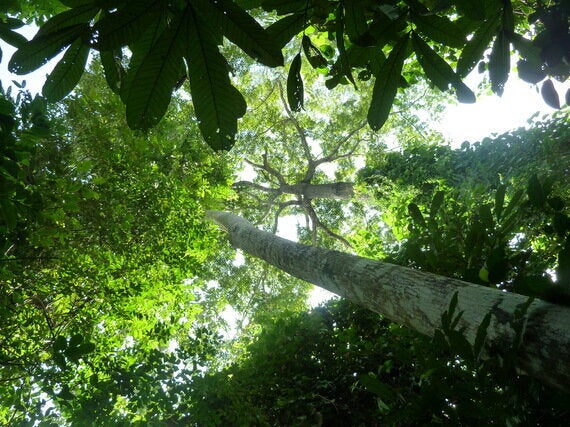
Tai Forest National Park Côte d'Ivoire (Tony Juniper)
On Thursday (March 16th) at a meeting hosted by The Prince of Wales a new initiative will be launched to save tropical rainforests from further clearance and degradation as a result of cocoa production. Twelve of the world's largest cocoa and chocolate companies, that have been working together in a process started by The Prince of Wales's International Sustainability Unit, the World Cocoa Foundation and The Sustainable Trade Initiative (IDH), will convene in London at a high level gathering to adopt a declaration committing them to action to halt deforestation and forest degradation.
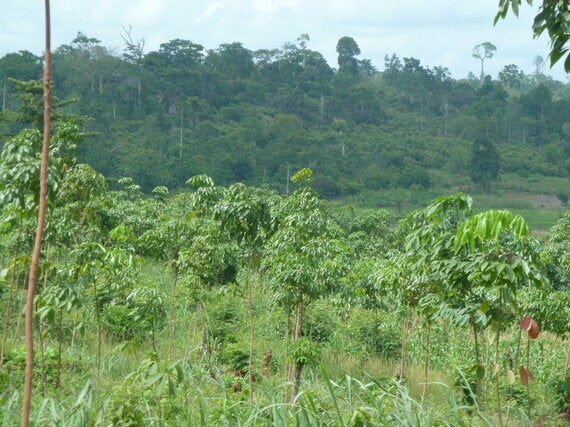
Forest-farm edge Côte d'Ivoire (Tony Juniper)
The global chocolate industry is worth tens of billions of dollars each year, growing from a discovery made about three thousand years ago in a Central American rainforest somewhere in what is present day Mexico or Guatemala, where a group of Olmec Indians were probably the first people ever to taste a chocolate-like food. They discovered that the 'beans' found in the fleshy pods of a rainforest tree had special properties, and initially consumed them in a drink. It took on mystical properties, was used in ritual and for medicinal purposes. When European explorers came across what the Indians had discovered they too thought it was very special and took seeds for propagation in other parts of the world.
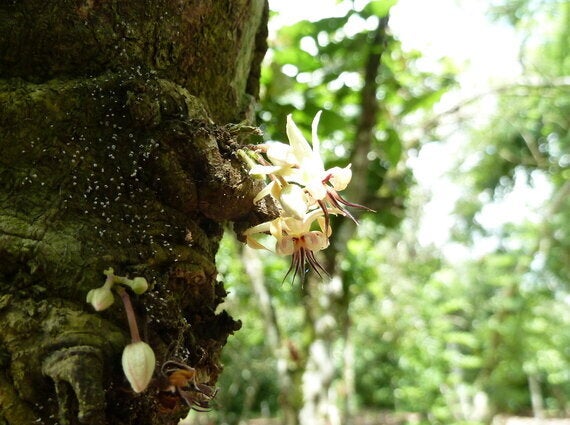
Cocoa flower (Tony Juniper)
Today cocoa trees are grown right around the Earth in the wet tropics within about ten degrees of latitude of the equator, mainly in smallholder plantations tended and harvested by a vast army of mostly poor farmers. On a few hectares each they grow the cocoa trees from which they harvest the pods that emerge from delicate white flowers on the trees' trunks and bigger branches. From these they extract the beans that are then dried out in the hot tropical Sun, before being shipped to market. These millions of farmers produce the cocoa that supplies the companies that make the wonderful chocolate products that fill airport duty-free shelves, corner shops and supermarket displays right around the world.
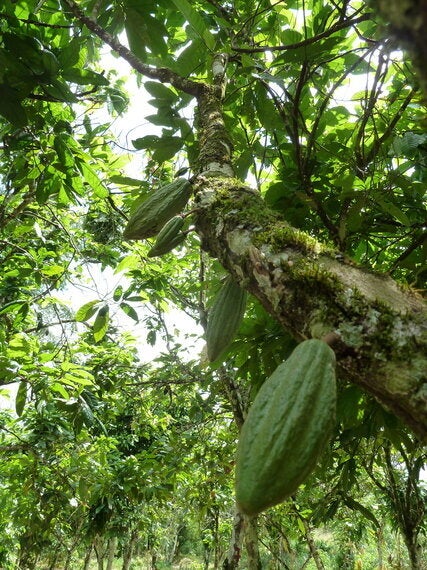
Cocoa pods (Tony Juniper)
About 60 per cent of the huge quantity of cocoa we need comes from just two countries: the West African nations of Côte d'Ivoire and Ghana. Their national economies and vast populations of farmers - many of whom live below the poverty line - depend on cocoa. During recent decades the area under cocoa has dramatically increased, in the process replacing much of the tropical rainforests that once stretched in an unbroken belt from eastern Ghana in the east to Sierra Leone and Guinea in the west. In Ghana and Côte d'Ivoire there is today little of the original tropical rainforest left and what does remain is under pressure as a result of expanding rural populations seeking livelihoods from cocoa farming, including globally important areas such as the Tai Forest National Park. Given this context, the new Forests and Cocoa initiative will initially focus its attention in these two countries.
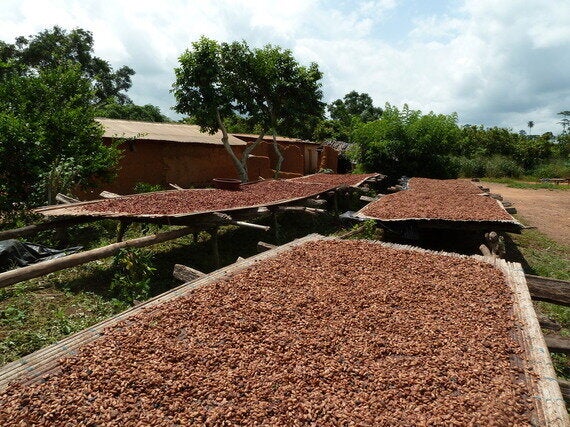
Cocoa beans drying in the Sun Côte d'Ivoire (Tony Juniper)
These now fragmented and depleted West African rainforests, the so-called Upper Guinea Forests, are nonetheless still of global importance, not least because of the host of rare wildlife species they harbour, including tool-using chimpanzees, forest elephants, pygmy hippopotamus and strange forest birds called white-necked picathartes. They also have millions of tonnes of carbon locked away in their vegetation and these rainforests are also important for regional rainfall, with recent prolonged droughts at least in part linked with forest loss. Reduced rainfall is not only a problem for the poor farmers whose crops produce less when it is drier, however, but also the cocoa and chocolate companies who require growing supply to meet rising global demand. Cocoa is a rainforest species and the resilience of cocoa plantations is underpinned by the water flows generated by rainforests.
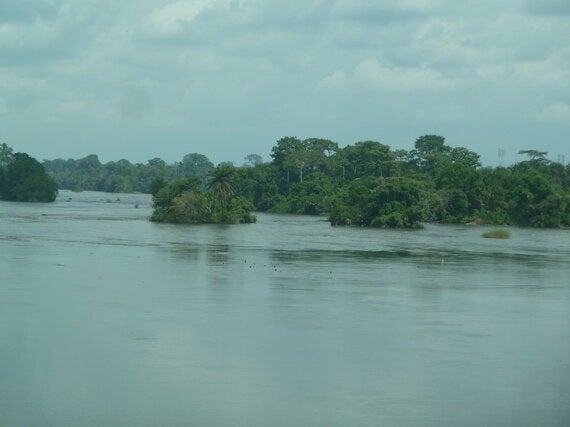
Rainforest river Côte d'Ivoire topped up by heavy rains (Tony Juniper)
The companies at the meeting, including Nestlé, Mars, Ferrero, Hershey's and Mondelēz International (who manufacture among many other things Toblerone and Cadbury's Dairy Milk), will discuss how, alongside ensuring forests are properly protected from encroachment, that the task at hand is essentially about enabling farmers to produce more from the existing farmed land, thereby reducing pressures on the remaining forests. Many commodity companies have during recent years increasingly come to accept that rising output does not need to involve further forest loss, and indeed it mustn't do if the rain needed for long-term food security is to be protected. This can be achieved, they've said, through a combination of reduced waste en route to market, better farming methods and supporting smallholder farmers.
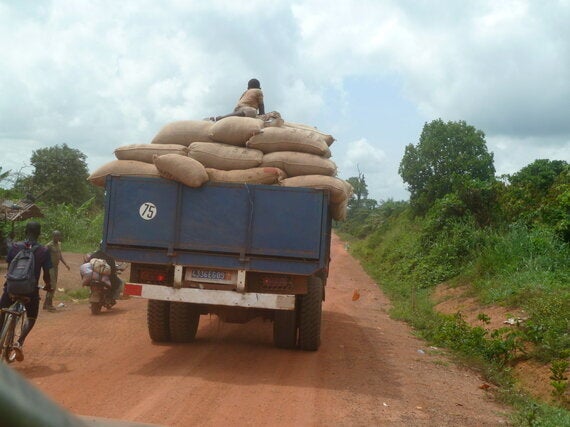
Cocoa en route to market Côte d'Ivoire (Tony Juniper)
Several companies in the cocoa and chocolate sector are already collaborating through an initiative called Cocoa Action to empower growers through education, training, improved market access and supply of higher yielding cocoa trees, as well as to address the persistent problem of child labour on cocoa farms, which is inextricably linked with the grinding poverty experienced on family farms. This week they will undertake to do more to protect forests as well. This is not least because all of the companies are increasingly aware of the extent to which forests shape climatic conditions both regionally and globally and realise that deforestation is a highly material and growing business risk. For the same reasons governments too are increasingly interested in partnering with companies in avoiding further deforestation and Ministers from the two priority countries will be at the meeting as well, to express their interest in further collaboration on forest protection and restoration.
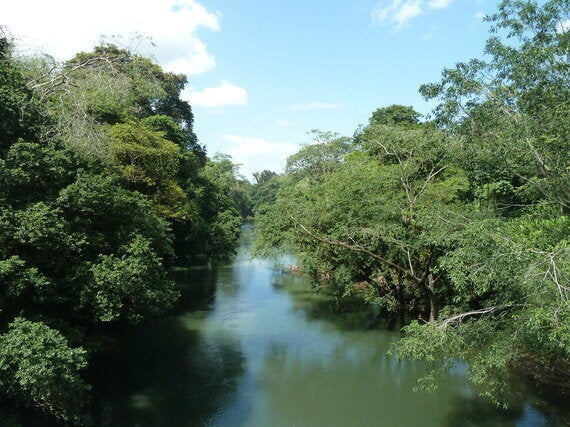
Intact tropical rainforest (Tony Juniper)
An important part of the forward agenda for the cocoa industry must also embrace the risks that could come from rapid cocoa expansion in Asia and Central and South America, where growing markets in Malaysia, Indonesia, Colombia, Peru and Ecuador could lead to increased pressure on natural forests. There is also momentum for cocoa cultivation to expand in other parts of Africa, where the crop could soon be a potential driver for further deforestation in Liberia, Cameroon and the Congo basin. The challenge is thus evidently as much about anticipating future challenges in those and other countries, as well as doing better in those that are already major producers.
The Prince of Wales is expected to congratulate the companies for taking this week's additional step and to encourage them to scale up their efforts in the knowledge that it is indeed possible to increase food production while at the same time conserving and restoring the tropical rainforests.

Chocolate in duty free shop (Godiva)
Following this week's meeting more cocoa and chocolate companies are expected to join the initiative. That growing group of businesses will work together with the World Cocoa Foundation and the Sustainable Trade Initiative on a further planning and consultation process, including with farmer groups and non-governmental organisations, to bring a joint framework to the climate change talks convened by Fiji at the end of 2017 and taking place in Bonn, Germany.
Perhaps as a result of these efforts the warm feelings engendered by the world's ultimate comfort food could be all the more pleasant, if companies can indeed successfully build forest protection and restoration into how they procure their most vital and amazing ingredient.
